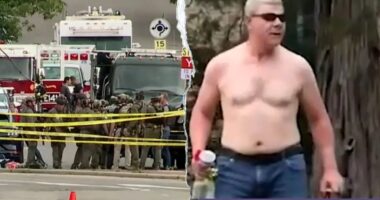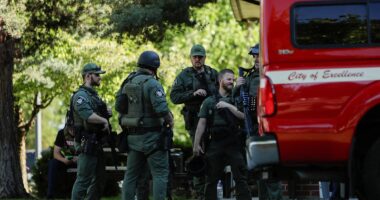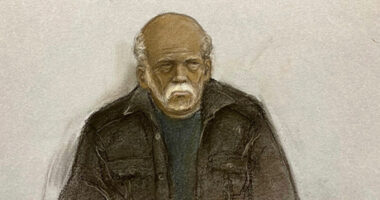
Scientists have reconstructed the face of the man who served as the inspiration for Santa Claus after almost 1,700 years, based on his skull.
Saint Nicholas of Myra, an early Christian saint known for his gift-giving, influenced the creation of Sinterklaas in Dutch folklore, which eventually evolved into the modern Santa Claus in the United States.
Over time, the image of this legendary figure combined with the English Father Christmas, traditionally linked with feasting and activities rather than presents, giving rise to the beloved character cherished by children today.
Yet no depiction of the man behind the myth survives from his lifetime, with most representations of ‘Old Saint Nick’ dating to centuries after his death in 343 AD.
Now his living face can be seen for the first time since the days of the Late Roman Empire, after experts forensically rebuilt his features using his skull.
Mr Moraes, lead author of the new study, said it was a ‘strong and gentle face’.
He said it was also ‘curiously compatible’ with the ‘broad face’ described in the 1823 poem, A Visit From St Nicholas, widely known as ‘Twas The Night Before Christmas.
He said: ‘The skull has a very robust appearance, generating a strong face, as its dimensions on the horizontal axis are larger than average.
‘This resulted in a “broad face” curiously compatible with the 1823 poem.
‘This characteristic, combined with a thick beard, is very reminiscent of the figure we have in mind when we think of Santa Claus.’
José Luís Lira, Mr Moraes’ co-author and an expert on the lives of saints, described the significance of the real Nicholas of Myra.
He said: ‘He was a bishop who lived in the early centuries of Christianity and had the courage to defend and live the teachings of Jesus Christ, even at the risk of his life.
‘He challenged the authorities, including the Roman Emperor, for this choice.
‘He helped those in need so frequently and effectively that when people sought a symbol of kindness for Christmas, the inspiration came from him.
‘His memory is universal not only among Christians, but among all peoples.’
Mr Moraes explained how the famous saint became the folk legend of today.
He said: ‘The Protestant Reformation, led by Martin Luther, was a movement that contributed to the disappearance of devotion to Saint Nicholas in many countries.
‘A notable exception was in the Netherlands, where the legend of Sinterklaas – which is a linguistic suppression of the saint’s name – remained strong, even influencing the colonies of that nation.
‘One of these colonies was the city of New Amsterdam, today New York, where the legend was anglicised into the name Santa Claus.
‘He was described as an old man who punished misbehaving children and rewarded those who behaved well with gifts.’
He continued: ‘The image of Santa Claus as we know it today is based on an illustration by Thomas Nast for Harper’s Weekly magazine in early 1863.
‘This in turn was inspired by the description in the 1823 poem A Visit from St. Nicholas attributed to Clement Clarke Moore.’
The poem gave rise to many popular notions about the folk figure we have today, including his rosy cheeks, his reindeer, his sleigh, his sack of toys, and the ‘broad face’ described earlier.
To create the face, Mr Moraes and his team used data collected in the 1950s by Luigi Martino, with permission from the Centro Studi Nicolaiani.
He said: ‘We initially reconstructed the skull in 3D using this data.
‘We then traced the profile of the face using statistical projections.
‘We supplemented this with the anatomical deformation technique, in which the tomography of a living person’s head is adjusted so that the virtual donor’s skull matches that of the saint.
‘The final face is an interpolation of all this information, seeking anatomical and statistical coherence.’
The result is two sets of images: one objective in greyscale, and one more artistic – adding features like a beard and clothes, inspired by the iconography of Saint Nicholas.
The remains of the saint reveal more than just his face, however.
Mr Moraes said: ‘He apparently suffered from severe chronic arthritis in his spine and pelvis, and his skull showed bone thickening that could cause frequent headaches.
‘According to this source, his diet would be mostly plant-based.’
In life, Saint Nicholas was Bishop of Myra, in what is now Turkey.
Various deeds are attributed to him, including saving three girls from prostitution by paying a dowry for each, allowing them to be married.
He’s also said to have resurrected three children murdered by a butcher, who had pickled them in brine and planned to sell them as pork.
Initially interred in Myra, his bones were later removed to Bari in Italy, where they remain today.
Mr Moraes, Dr Lira and their co-author, Thiago Beaini, published their study in the journal OrtogOnLineMag.
















